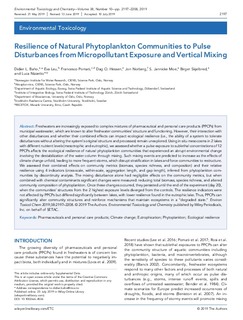| dc.description.abstract | Freshwaters are increasingly exposed to complex mixtures of pharmaceutical and personal care products (PPCPs) from municipal wastewater, which are known to alter freshwater communities’ structure and functioning. However, their interaction with other disturbances and whether their combined effects can impact ecological resilience (i.e., the ability of a system to tolerate disturbances without altering the system's original structure and processes) remain unexplored. Using in situ mesocosms in 2 lakes with different nutrient levels (mesotrophic and eutrophic), we assessed whether a pulse exposure to sublethal concentrations of 12 PPCPs affects the ecological resilience of natural phytoplankton communities that experienced an abrupt environmental change involving the destabilization of the water column through mixing. Such mixing events are predicted to increase as the effects of climate change unfold, leading to more frequent storms, which disrupt stratification in lakes and force communities to restructure. We assessed their combined effects on community metrics (biomass, species richness, and composition) and their relative resilience using 4 indicators (cross‐scale, within‐scale, aggregation length, and gap length), inferred from phytoplankton communities by discontinuity analysis. The mixing disturbance alone had negligible effects on the community metrics, but when combined with chemical contaminants significant changes were measured: reducing total biomass, species richness, and altered community composition of phytoplankton. Once these changes occurred, they persisted until the end of the experiment (day 20), when the communities’ structures from the 2 highest exposure levels diverged from the controls. The resilience indicators were not affected by PPCPs but differed significantly between lakes, with lower resilience found in the eutrophic lake. Thus, PPCPs can significantly alter community structures and reinforce mechanisms that maintain ecosystems in a “degraded state.” | nb_NO |

